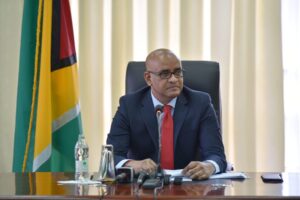March 27 ,2021
Kaieteur News – The Irfaan Ali led administration is steadfast in its plan to land a multibillion dollar pipeline at Wales, West Bank Demerara, for the proposed gas-to-shore project despite the widespread criticism it has faced from industry experts.
Many share the same concern that Government is moving too fast and should pump their breaks, at least until a thorough plan is laid out to show exactly how the project will benefit Guyanese.

Vice President, Dr. Bharrat Jagdeo
Vice President (VP) and local oil boss, Dr. Bharrat Jagdeo, has touted a reduction in electricity costs as one of the most crucial benefits to be had. On this premise, no financial feasibility study will be conducted, as according to the VP, that aspect is “a no-brainer.”
But International Environmental Lawyer, Melinda Janki is taking him to task on his comments, and is now challenging Dr. Jagdeo to present irrefutable evidence in support of his claim.
“Vice-President Jagdeo claims that the gas-to-shore project will benefit the Guyanese. Where is the Vice-President’s evidence?” Janki asked, in her comment to Kaieteur News.
“If gas is such a good thing, why can’t ExxonMobil sell it on the open market? Why doesn’t anybody want to buy Guyana’s associated gas? (It’s) because it’s worthless,” she continued.
Janki also alluded to statements made by Tom Sanzillo, Director of financial analysis at the Institute for Energy Economics and Financial Analysis (IEEFA), that the intended gas-to-shore project could prove financially damaging to Guyana.
Sanzillo had made the point that although he can appreciate Government’s inclination to respond to the rising demand for electricity while addressing black out woes, Guyana’s modus operandi when negotiating the lopsided oil contract gives no evidence that it can do right when bringing gas to shore.
Janki then asked, “IEEFA says this gas project could bankrupt Guyana. Can the Vice-President answer IEEFA’s financial assessment? Whom do the Guyanese people believe? A Government that has no experience of gas or the expert analysis of an international energy body that is decades old.”
The International Lawyer also pointed to a World Bank report titled ‘Energy Markets in Latin America Emerging disruptions and the Next Frontier,’ which stated, “In countries such as Suriname, Guyana, Ecuador, Paraguay, and most of Central America and the Caribbean, natural gas demand is small or non-existent.”
With that said, Janki opined that Guyana ought to be moving in a different direction – solar.
She backed up her statements pointing to the International Energy Agency’s (IEA) World Energy Outlook for 2020. Janki noted that the IEA had offered a highly influential annual outlook with four “pathways” to 2024, all of which see a major rise in renewables. She noted that the IEA’s main scenario has 43% rise in solar power output by 2024, over wind energy and hydro power with solar presenting itself as the cheapest option.
While natural gas is known as the cleanest burning fossil fuel, it is not cheap to produce, as millions of dollars are needed to secure gas pipelines and infrastructure to covert the natural gas into useable power.
Presently, the crude estimation for Guyana’s gas-to-shore project stands at US$500-800 million, depending on the design, pipeline size and surveys.
Janki had taken Government to task regarding the gas-to-shore project before. On that occasion, she had called on President, Irfaan Ali, to provide to the nation, evidence that the project was economically sound.
Janki asked the President to present a Natural Gas Business Plan, which provides a comprehensive, quantitative and qualitative presentation of the Guyana natural gas project.
The presentation, she outlined should include, but not be limited to, a brief description of the major facilities to be constructed (drilling and extraction, offshore and onshore pipelines and natural gas power stations) including capacity, size, estimated start and completion of construction and anticipated lifecycle; comprehensive, estimated construction costs of each facility and an aggregate cost assessment and construction cash flow from ground breaking to commercial operation; and a comprehensive 30-year business plan of each individual facility and, if integrated, the plan should specify the operational assumptions.
She had requested that President Ali provide, as well, an Energy Plan outlining Guyana’s electric utility’s resource needs to meet expected demand over the next 30 years and the assumed additions and retirements, cost and performance assumptions used in the plan. This is yet to be done.


